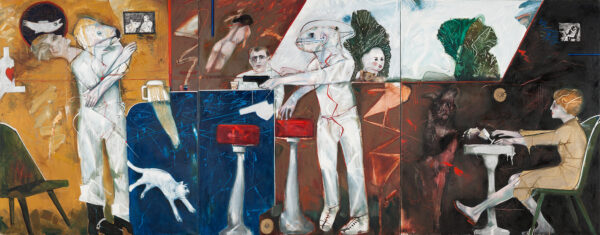
Death of Danny Graff, The
Davis, James G.
1987
Artwork Information
-
Title:
Death of Danny Graff, The
-
Artist:
Davis, James G.
-
Artist Bio:
American, 1931–2016
-
Date:
1987
-
Medium:
Oil on canvas
-
Dimensions:
77 1/4 x 194 3/4 inches
-
Credit Line:
Wichita Art Museum, Gift of the Estate of William A. Small, Jr.
-
Object Number:
1994.11a,b,c
-
Display:
Not Currently on Display
About the Artwork
James G. Davis
American, 1931–2016
The Death of Danny Graff, 1987
Oil on canvas
Wichita Art Museum, Gift of the Estate of William A. Small, Jr.
1994.11a,b,c
In 1962 the Wichita Art Museum presented a Kansas Artists Annual purchase award for the painting Pink Ribbon to recent Wichita State University graduate James G. Davis. Since that time Davis has traveled, worked, and exhibited in the American Southwest, Mexico, Germany, and New York City where he has earned critical respect for the extraordinary emotional power and sensuous technical qualities of his imagery.
The Wichita Art Museum’s acquisition of Davis’s monumental triptych, The Death of Danny Graff, completes the earlier piece with an important representation of the artist’s mature work. This painting exemplifies Davis’s applications of the gestural painting style of the abstract expressionist to a surreal narrative montage of events derived from life, art, and imagination.
In The Death of Danny Graff, the artist translated two personal remembrances; the shooting of a young friend in a small town bar, and a white cat which went wild and had to be shot, into a metaphor for a more universal anxiety about death and violence.
Artist’s Statement:
The Death of Danny Graff is a painting of a friend killed in a bar. The painting was started in the summer and continued into the fall of 1986 in West Berlin, Germany. It is about an incident which occurred a long time ago in a small town in Missouri. Although it may seem strange that something that happened so long ago and far away would be the source for this piece in Berlin, that year it seemed very appropriate. . . . with the atmospheric mixture of high anxiety, intensity, and episodes of instant violence.
I worked on several paintings relating to memorials and dedications and had just finished a large white painting dedicated to Kafka, The Castle and Herr Klamm. . . . . a sort of palpable heavy transparency of moving bodies . . . . one of the more recognizable images in the painting was the gun under Klamm’s arm. I wanted to continue this concept of contained and/or demonstrated violence but with another source: something personal or even autobiographical, with color suggesting a particular place. I had been thinking about Danny for years so that this particular “place” would be a bar with red, cracked plastic bar stools, dark brown smoky wood, saturated ghosts in a contained edgy atmosphere. I wanted to imply something urgent but helpless, frozen glances and movements, transformations instantaneous and final.
Expressionism was at its height in Germany at this time. Writing by Ibsen, Kafka, and Munch prints were getting a lot of my attention. Some of this relates to the images in the painting which are a mixture of illusion, disguise, and metaphor leading to a point I hope that we ca